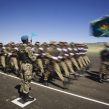
Nazarbayev Promises Modernized Armed Forces in Kazakhstan
Publication: Eurasia Daily Monitor Volume: 10 Issue: 91
By:

While the phenomenon of the military parade has lost much of its former appeal in Western media coverage, with sporadic mention of the Russian show of arms on Red Square on May 9 marking Victory Day, a less well publicized recent event in southern Kazakhstan showcased that country’s Armed Forces. What was so unusual about the “parade” in Kazakhstan is not only that it is the first of its kind in the country since independence, but also the choice by the political leadership to stage this beyond the capital. Kazakhstan’s first military combat parade took place at the 40th military base in Otar, Zhambyl Region on May 7, to commemorate the 21st anniversary of the creation of the country’s Armed Forces; and both its scale and recent comments by the political-military leadership suggest that the military will be modernized rapidly as Kazakhstan profits from its booming energy wealth (Interfax, May 7).
Khabar TV displayed images of President Nursultan Nazarbayev arriving by helicopter at the base to witness the first “combat parade” in the country. More than 7,000 servicemen were involved, 400 pieces of military hardware and up to 90 aircraft and helicopters. Nazarbayev also described the show of arms as the largest “military exercise” ever held in Kazakhstan. “This is one of our largest exercises. At the same time, Kazakh navy ships will conduct live firing in the Caspian Sea. On this day officers and soldiers will prove in practice that they are true patriots and professionals of their combat work, the motto of which sounds powerfully and courageously: ‘Strong Army—Strong Kazakhstan!’” Nazarbayev said (Khabar TV, Kazinform, May 7).
During rehearsals for the event held on May 3, pilots performed aerial acrobatics using MiG-29, SU-27 and L-39 aircraft. An Airbus C-295 was used to drop airmobile forces, while combat launches of ground-to-air missiles at notional “targets” were performed from an S-125 quadruple launcher. Plans were also drawn up to use the C-295 to land on a dirt track close to the Caspian coast, presumably to display the Armed Forces’ capability to rapidly move small numbers of troops and deploy across large distances during a future crisis (Tengrinews, May 6).
The state-owned news agency Kazinform reported on the naval elements of the “combat parade” staged in the Caspian Sea. A group of Kazakhstani naval vessels were grouped at a distance of 20 kilometers from the Kazakhstani coastline, before the “Kazakhstan” was used to fire at hypothetical sea-based targets. The “Kazakhstan” is the country’s first warship built by its fledgling domestic defense industry, and introduced into service to boost Caspian security. The warship itself has an advanced detection system, as well as digitized communications and navigational equipment (Kazinform, May 7).
Underlying the pomp and ceremony of the “combat parade,” however, are much deeper developments in Kazakhstan’s Armed Forces, particularly focused upon the promise by Nazarbayev to modernize these structures and introduce more new and high technology–based platforms. In this context, the day before the military show was conducted, Colonel-General Saken Zhasuzakov, Kazakhstan’s chief of the General Staff and first deputy defense minister, claimed that Astana is capable of upgrading the Army to meet 21st century standards. This demands long-term transformation and considerable investment in the future shape of the military, which, according to Zhasuzakov, is occurring at present in overhauling and enhancing the system of military education. Yet, Zhasuzakov set out a highly ambitious agenda for the Armed Forces in three specific areas: informatization, robotization and intellectualization. “Upon the achievement of these three strategic goals, I think the armed forces of the Republic of Kazakhstan will meet 21st century army standards. We have the appropriate ways and means, trained personnel and, what is most important, the support of our commander-in-chief and government,” he explained during a press conference in Otar (Interfax, May 6).
These aspirational statements imply that Kazakhstan’s Armed Forces will continue to experience force modernization over a considerable period, and the state will equally need to inject serious investment in such projects, especially to support the domestic defense industry. However, such levels of modernization will place a greater burden on military personnel, not only compelling the Armed Forces to recruit, train and retain higher numbers of contract personnel, but to expand the recruitment basis in order to attract bright and talented young men to serve. In March 2013, the defense ministry introduced a new principle of staffing the Armed Forces with officers and recruiting contract personnel. On March 1, the military opened 34 centers across the country to recruit contract personnel. These will function in cities and towns and target individuals with no previous military experience (Interfax, March 28).
“Strong Army—Strong Kazakhstan!” seems to be a populist slogan from the country’s first president, and the plans to modernize the Armed Forces around information, robotics and intellectualization while introducing new advanced hardware represents the most ambitious military agenda in Central Asia. The question is what is driving this desperate effort to create advanced high technology–based military capabilities. It is unlikely that any of the internal or external threats to the state outlined in its published security documents may account for such an agenda. Equally, the advances being made in developing naval capabilities in the Caspian Sea (see EDM, April 24) hardly qualify as flexing military muscle; it does little to change the fact that Russia remains the dominant sea power in the Caspian region. The real answers are to be found in the nature of the regime itself, where possessing such assets is increasingly seen as a status symbol; but the consequences may be unpredictable as such advances in military capability are bound to provoke a response of some kind by other actors in the neighborhood.




